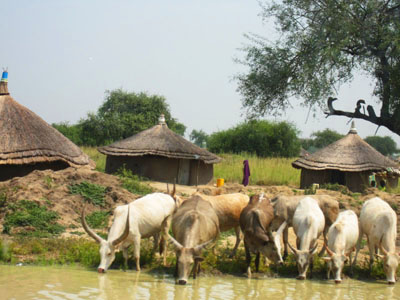
JUBA, Southern Sudan — I recently returned to my base in the capital of southern Sudan from a field research trip to Jonglei state. According to the 2008 census, Jonglei is the most populous southern state, but its vast territory largely lacks the most basic infrastructure to connect villages and towns throughout the state.
Jonglei has been the site of much of the inter-ethnic violence that has wracked the South this year, resulting in the deaths of more than 2,000 people and displacing at least 350,000. I traveled to Twic East County, where tensions are running high between the Dinka and Lou Nuer populations after several attacks and violent reprisals in recent months. I also visited the town of Duk Padiet, where more than 100 people were killed on September 20 in an attack by a militia comprised of men from the Lou Nuer group on the Dinka community. Although there are a number of trends and dynamics shaping the volatile environment in Jonglei today, I focused on examining the tensions between Dinka and Nuer populations in the areas immediately north of Bor, the capital of Jonglei state.
As a longtime southern Sudan observer told me, this part of Jonglei is “ground zero” for the split that emerged within the SPLA in 1991 – now the army of southern Sudan, but at the time the South’s armed movement fighting against the North’s Sudan Armed Forces. The “SPLA split” was a landmark development during the war and resulted in Khartoum’s sponsorship of several key southern commanders, notably Riek Machar, current vice president of the Government of Southern Sudan. The split permanently affected the dynamics of the southern movement during the war and continues to cast a shadow over politics in South Sudan. As a young researcher, it might seem ironic for me to say so, but understanding the history of decades of conflict in southern Sudan is essential to unpacking the dynamics of what is occurring at this key moment in the South. (For a comprehensive overview of the SPLA split, read Douglas Johnson’s Root Causes of Sudan’s Civil Wars, which is worth buying just for this chapter and is a must-read tome in general for anyone following Sudan.)
Speaking with Dinka victims in Duk Padiet and to disaffected Nuer students in Bor confirmed the “ground zero” idea. Real animosity exists between these groups, not only because of current political tensions in the waning period of implementation of the Comprehensive Peace Agreement, but certainly because of the still-fresh memories of the civil war.
It is interesting to see how these tensions, which seemed openly acknowledged in rural areas in Jonglei, are playing out in Juba.
The other day, I interviewed a high-level SPLA commander who led a sizeable Nuer militia during the civil war and received considerable backing from the Khartoum regime, consistently working to undermine the “mainstream” SPLA movement led by the late Dr. John Garang. After the interview, the commander’s son gave me a ride to my next meeting. On the road, we passed a police officer who was directing traffic and stopped us to ask him something (though I am not sure what because the police officer spoke in Dinka). The commander’s son, a Nuer speaker like his father, seemed to snap at the man, and they had a short but heated exchange. As we drove away, the commander’s son complained that the Dinka police officer had spoken to him in Dinka, and he had responded in Arabic, assuming the police officer spoke Arabic (which was the primary language taught in schools throughout the South from independence until the 2005 peace deal). Oddly, this exchange was almost as useful as the interview with the military commander, as it provided a snapshot of the broader issues facing the South today.
As my coming posts will examine, a number of unresolved issues within the South, compounded by North-South tensions, are contributing to a feeling of tension in the air that is hard to ignore – from “ground zero” in Jonglei state to the streets of Juba.

